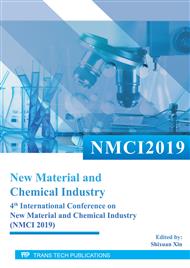[1]
Dong Lijian, Wangbiao. Systematical analysis of paraffin deposits and discussion on mechanism of paraffin deposition in production wells of Tuha oilfield in xinjiang. Oilfield Chemistry, 2 (1995): 113-116.
Google Scholar
[2]
Zhao Zuozi, Ren Jianke, Liu Zhenxiang, et al. Study of paraffin deposits in production well of tulufan-hami oilfield and development of solid paraffin deposition inhibitors of CQ-2 type. Oilfield Chemistry, 2 (1995): 106-112.
Google Scholar
[3]
Li Jiong. Study on the application of flow improver on the long distance crude pipelines. Oilfield Chemistry, 2 (1987): 146-155.
Google Scholar
[4]
Zhang Fusheng, Wangbiao, Xie Huizhuan, et al. Application of pour point depressants for crude oil in long distance pipeline transportation of China. Oilfield Chemistry, 4 (1999): 368-371.
Google Scholar
[5]
Shize Yi, Jinjun Zhang. Shear-induced change in morphology of wax crystals and flow properties of waxy crudes modified with the pour-point depressant. Energy & Fuels, 12 (2011): 5660-5671.
DOI: 10.1021/ef201187n
Google Scholar
[6]
An Jiarong, Qiao Mengchen. The influence of high- speed shear on the rheological behavior of the crude oil with depressant in Dingjing three pipeline. Oil & Gas Storage and Transportation, 1 (2017): 8-10.
Google Scholar
[7]
Xin Yanping. Influence of shear history on the rheological properties of waxy crude oil. Science Technology and Engineering, 7 (2015): 1-4.
Google Scholar
[8]
Yi Shize, Zhang Jinjun. Cogitation on the research of the how shear effect influences the flow properties of PPD-beneficiated waxy crude oil. Oil & Gas Storage and Transportation, 6 (2008): 5-9.
Google Scholar
[9]
Yu Tao, Gu Jiandong, Yin Binggang, et al. The effects of shear history on the physical properties of Tuha oils in west pipelines. Oil & Gas Storage and Transportation,1 (2012): 71-74.
Google Scholar
[10]
Lei Qun, Zhang Fusheng, Guan Baoshan, et al. Influence of shear on rheology of the crude oil treated by flow improver. Energy Reports, 5 (2019): 1156-1162.
DOI: 10.1016/j.egyr.2019.08.009
Google Scholar
[11]
Barasha Deka, Rohit Sharma, Arnab Mandal, at al.. Synthesis and evaluation of oleic acid based polymeric additive as pour point depressant to improve flow properties of Indian waxy crude oil. Journal of Petroleum Science and Engineering, 170 (2018): 105-111.
DOI: 10.1016/j.petrol.2018.06.053
Google Scholar
[12]
Wu Yumin, Ni Guangdi, Yang Fei, et al. Modified maleic anhydride co-polymers as pour-point depressants and their effects on waxy crude oil rheology. Energy & Fuels, 2 (2012): 995-1001.
DOI: 10.1021/ef201444b
Google Scholar
[13]
Liu Tao, Fang Long, Liu Xin, et al. Preparation of a kind of reactive pour point depressant and its action mechanism. Fuel, 143 (2015): 448-454.
DOI: 10.1016/j.fuel.2014.11.094
Google Scholar
[14]
Ahmed NS, Nassar AM, Nasser R M, et al. Novel terpolymers as pour point depressants and viscosity modifiers for lube oil. Petroleum Science and Technology, 6 (2014): 680-687.
DOI: 10.1080/10916466.2011.604058
Google Scholar
[15]
Khidr TT. Pour point depressant additives for waxy gas oil. Petroleum Science and Technology, 29 (2011): 19-28.
DOI: 10.1080/10916460903330155
Google Scholar
[16]
Yi Shize, Zhang Jinjun. Cogitation on the research of the how shear effect influences the flow properties of PPD-beneficiated waxy crude oil. Oil & Gas Storage and Transportation, 6 (2008): 5-9.
Google Scholar
[17]
Li Yufeng, Zhang Jinjun, Huang Qiyu, et al. Shear effect on the viscosity and gel point of Daqing waxy crude beneficiated by pour point depressan. Oil & Gas Storage and Transportation, 10 (2004): 29-32.
Google Scholar
[18]
Zhang Jijun, Huang Qiyu,Yan Dafan. Estimation of average shear rate in stirred vessels for pipelining shear simulation. Acta Petrolei Sinica, 2 (2003): 94-96.
Google Scholar
[19]
Zhang Jijun, Yan Dafan. Calculation of average shear rate in pipe flow based on energy dissipation rate Acta Petrolei Sinica, 5 (2002): 88-90.
Google Scholar
[20]
SY/T0541-2009. Chinese Petroleum and Natural Gas Industry standard Test method for gel point of crude oils,.
Google Scholar
[21]
SY/T0520-2008. Chinese Petroleum and Natural Gas Industry standard Viscosity determination of crude petroleum-equilibrium method by rotational viscometer,.
Google Scholar


